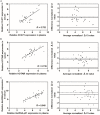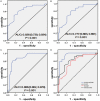Combined identification of long non-coding RNA CCAT1 and HOTAIR in serum as an effective screening for colorectal carcinoma
- PMID: 26823726
- PMCID: PMC4713512
Combined identification of long non-coding RNA CCAT1 and HOTAIR in serum as an effective screening for colorectal carcinoma
Abstract
Long non-coding RNAs (lncRNAs) CCAT1 and HOTAIR have been shown to play an important regulatory role in cancer biology, and CCAT1 and HOTAIR are upregulated in several cancers, however, its value in the diagnosis of colorectal cancer (CRC) is unclear. Therefore, the aim of this study is to evaluate the clinical significance of plasma CCAT1 and HOTAIR as a biomarker in the screening of CRC. In our study, we found that the levels of HOTAIR (P < 0.05) and CCAT1 (P < 0.05) were significantly higher in plasma of CRC patients than that of the healthy control. Moreover, the levels of lincRNA-p21 (P < 0.05) were obviously decreased in plasma of CRC patients as compared to those of healthy control. There was highly correlated for CCAT1 (R = 0.752, mean differences = -0.06 ± 1.20), HOTAIR (R = 0.739, mean differences = -0.26 ± 0.76) and lincRNA-p21 (R = 0.848, mean differences = -0.41 ± 0.89) in plasma and serum. By receiver operating characteristic curve (ROC) analysis, plasma CCAT1 provided the higher diagnostic performance for detection of CRC (the area under the ROC curve (AUC), 0.836; P < 0.001; sensitivity, 75.7%; specificity, 85.3%). Moreover, CCAT1 combining with HOTAIR could provide a more effective diagnosis performance (AUC, 0.954, P < 0.001, sensitivity, 84.3%; specificity, 80.2%). Most importantly, this combination was effective to detect CRC at an early stage (85%). In conclusion, our results demonstrated that increased plasma HOTAIR and CCAT1 could be used as a predictive biomarker for CRC screening, and that combination of HOTAIR and CCAT1 had a higher positive diagnostic rate of CRC than HOTAIR or CCAT1 alone.
Keywords: CCAT1; Colorectal carcinoma; HOTAIR; long non-coding RNA; tumor biomarker.
Figures





Similar articles
-
Diagnostic and prognostic potential of tissue and circulating long non-coding RNAs in colorectal tumors.World J Gastroenterol. 2019 Sep 14;25(34):5026-5048. doi: 10.3748/wjg.v25.i34.5026. World J Gastroenterol. 2019. PMID: 31558855 Free PMC article. Review.
-
Exosomal long noncoding RNA CRNDE-h as a novel serum-based biomarker for diagnosis and prognosis of colorectal cancer.Oncotarget. 2016 Dec 20;7(51):85551-85563. doi: 10.18632/oncotarget.13465. Oncotarget. 2016. PMID: 27888803 Free PMC article.
-
Combined identification of long non-coding RNA XIST and HIF1A-AS1 in serum as an effective screening for non-small cell lung cancer.Int J Clin Exp Pathol. 2015 Jul 1;8(7):7887-95. eCollection 2015. Int J Clin Exp Pathol. 2015. PMID: 26339353 Free PMC article.
-
Circulating long non-coding HOX transcript antisense intergenic ribonucleic acid in plasma as a potential biomarker for diagnosis of breast cancer.Thorac Cancer. 2016 Nov;7(6):627-632. doi: 10.1111/1759-7714.12373. Epub 2016 Aug 1. Thorac Cancer. 2016. PMID: 27755794 Free PMC article.
-
Non-coding RNAs Enabling Prognostic Stratification and Prediction of Therapeutic Response in Colorectal Cancer Patients.Adv Exp Med Biol. 2016;937:183-204. doi: 10.1007/978-3-319-42059-2_10. Adv Exp Med Biol. 2016. PMID: 27573901 Review.
Cited by
-
Comprehensive landscape and future perspectives of long noncoding RNAs (lncRNAs) in colorectal cancer (CRC): Based on a bibliometric analysis.Noncoding RNA Res. 2022 Oct 11;8(1):33-52. doi: 10.1016/j.ncrna.2022.10.001. eCollection 2023 Mar. Noncoding RNA Res. 2022. PMID: 36311994 Free PMC article.
-
Long non‑coding RNAs as diagnostic and prognostic biomarkers for colorectal cancer (Review).Oncol Lett. 2024 Aug 8;28(4):486. doi: 10.3892/ol.2024.14619. eCollection 2024 Oct. Oncol Lett. 2024. PMID: 39185489 Free PMC article. Review.
-
Diagnostic and prognostic potential of tissue and circulating long non-coding RNAs in colorectal tumors.World J Gastroenterol. 2019 Sep 14;25(34):5026-5048. doi: 10.3748/wjg.v25.i34.5026. World J Gastroenterol. 2019. PMID: 31558855 Free PMC article. Review.
-
lncRNA CCAT1 promotes bladder cancer cell proliferation, migration and invasion.Int Braz J Urol. 2019 May-Jun;45(3):549-559. doi: 10.1590/S1677-5538.IBJU.2018.0450. Int Braz J Urol. 2019. PMID: 31038865 Free PMC article.
-
Circulating Noncoding RNAs Have a Promising Future Acting as Novel Biomarkers for Colorectal Cancer.Dis Markers. 2019 Jun 3;2019:2587109. doi: 10.1155/2019/2587109. eCollection 2019. Dis Markers. 2019. PMID: 31275444 Free PMC article. Review.
References
-
- Qiu JJ, Yan JB. Long non-coding RNA LINC01296 is a potential prognostic biomarker in patients with colorectal cancer. Tumour Biol. 2015;36:7175–83. - PubMed
-
- Zheng ZX, Zheng RS, Zhang SW, Chen WQ. Colorectal cancer incidence and mortality in China, 2010. Asian Pac J Cancer Prev. 2014;15:8455–8460. - PubMed
-
- Ye HM, Lu YZ, Liang XM, Lin YZ, Li Y, Zhang ZY, Tzeng CM. Clinical significance of combined testing of YKL-40 with CEA in Chinese colorectal cancer patients. Clin Lab. 2014;60:397–405. - PubMed
Publication types
MeSH terms
Substances
LinkOut - more resources
Full Text Sources
Medical
